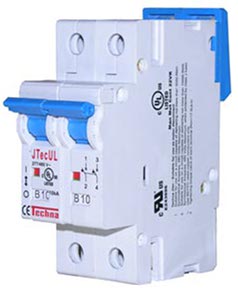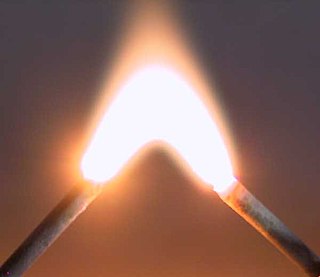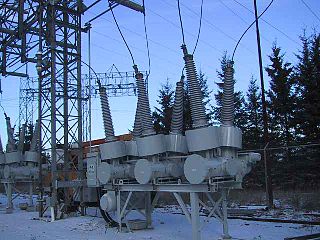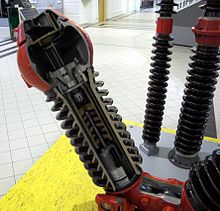
An electrical insulator is a material in which electric current does not flow freely. The atoms of the insulator have tightly bound electrons which cannot readily move. Other materials—semiconductors and conductors—conduct electric current more easily. The property that distinguishes an insulator is its resistivity; insulators have higher resistivity than semiconductors or conductors. The most common examples are non-metals.

In electrical engineering, a switch is an electrical component that can disconnect or connect the conducting path in an electrical circuit, interrupting the electric current or diverting it from one conductor to another. The most common type of switch is an electromechanical device consisting of one or more sets of movable electrical contacts connected to external circuits. When a pair of contacts is touching current can pass between them, while when the contacts are separated no current can flow.

A circuit breaker is an electrical safety device designed to protect an electrical circuit from damage caused by current in excess of that which the equipment can safely carry (overcurrent). Its basic function is to interrupt current flow to protect equipment and to prevent fire. Unlike a fuse, which operates once and then must be replaced, a circuit breaker can be reset to resume normal operation.

A substation is a part of an electrical generation, transmission, and distribution system. Substations transform voltage from high to low, or the reverse, or perform any of several other important functions. Between the generating station and consumer, electric power may flow through several substations at different voltage levels. A substation may include transformers to change voltage levels between high transmission voltages and lower distribution voltages, or at the interconnection of two different transmission voltages. They are a common component of the infrastructure. There are 55,000 substations in the United States.

In electronics and electrical engineering, a fuse is an electrical safety device that operates to provide overcurrent protection of an electrical circuit. Its essential component is a metal wire or strip that melts when too much current flows through it, thereby stopping or interrupting the current. It is a sacrificial device; once a fuse has operated, it is an open circuit, and must be replaced or rewired, depending on its type.

An electric switchboard is a piece of equipment that distributes electric power from one or more sources of supply to several smaller load circuits. It is an assembly of one or more panels, each of which contains switching devices for the protection and control of circuits fed from the switchboard. Several manufacturers make switchboards used in industry, commercial buildings, telecommunication facilities, oil and gas plants, data centers, health care, and other buildings, and onboard large ships. A switchboard is divided into different interconnected sections, generally consisting of a main section and a distribution section. These two sections are sometimes replaced by a combination section, which is a section that can fulfill the roles of both of the aforementioned sections. Switchboards can also sometimes come with an auxiliary section that is used to house devices that cannot be housed in the same section as other devices.

High voltage electricity refers to electrical potential large enough to cause injury or damage. In certain industries, high voltage refers to voltage above a certain threshold. Equipment and conductors that carry high voltage warrant special safety requirements and procedures.

An electric arc is an electrical breakdown of a gas that produces a prolonged electrical discharge. The current through a normally nonconductive medium such as air produces a plasma, which may produce visible light. An arc discharge is initiated either by thermionic emission or by field emission. After initiation, the arc relies on thermionic emission of electrons from the electrodes supporting the arc. An arc discharge is characterized by a lower voltage than a glow discharge. An archaic term is voltaic arc, as used in the phrase "voltaic arc lamp".

In electric power distribution, automatic circuit reclosers (ACRs) are a class of switchgear designed for use on overhead electricity distribution networks to detect and interrupt transient faults. Also known as reclosers or autoreclosers, ACRs are essentially rated circuit breakers with integrated current and voltage sensors and a protection relay, optimized for use as a protection asset. Commercial ACRs are governed by the IEC 62271-111/IEEE Std C37.60 and IEC 62271-200 standards. The three major classes of operating maximum voltage are 15.5 kV, 27 kV and 38 kV.
In electric power distribution and transmission, a Buchholz relay is a safety device mounted on some oil-filled power transformers and reactors, equipped with an external overhead oil reservoir called a "conservator".

An arc flash is the light and heat produced as part of an arc fault, a type of electrical explosion or discharge that results from a connection through air to ground or another voltage phase in an electrical system.

High-voltage switchgear is any switchgear used to connect or disconnect a part of a high-voltage power system. This equipment is essential for the protection and safe operation, without interruption, of a high voltage power system, and is important because it is directly linked to the quality of the electricity supply.

In electrical engineering, isolated-phase bus (IPB), also known as phase-isolated bus (PIB) in some countries, is a method of construction for circuits carrying very large currents, typically between a generator and its step-up transformer in a steam or large hydroelectric power plant.

An electric power system is a network of electrical components deployed to supply, transfer, and use electric power. An example of a power system is the electrical grid that provides power to homes and industries within an extended area. The electrical grid can be broadly divided into the generators that supply the power, the transmission system that carries the power from the generating centers to the load centers, and the distribution system that feeds the power to nearby homes and industries.

Sulfur hexafluoride circuit breakers protect electrical power stations and distribution systems by interrupting electric currents, when tripped by a protective relay. Instead of oil, air, or a vacuum, a sulfur hexafluoride circuit breaker uses sulfur hexafluoride (SF6) gas to cool and quench the arc on opening a circuit. Advantages over other media include lower operating noise and no emission of hot gases, and relatively low maintenance. Developed in the 1950s and onward, SF6 circuit breakers are widely used in electrical grids at transmission voltages up to 800 kV, as generator circuit breakers, and in distribution systems at voltages up to 35 kV.
A hybrid switchgear is one that combines the components of traditional air-insulated switchgear (AIS) and SF6 gas-insulated switchgear (GIS) technologies. It is characterized by a compact and modular design, which encompasses several different functions in one module.
This glossary of electrical and electronics engineering is a list of definitions of terms and concepts related specifically to electrical engineering and electronics engineering. For terms related to engineering in general, see Glossary of engineering.

In electrical engineering, a vacuum interrupter is a switch which uses electrical contacts in a vacuum. It is the core component of medium-voltage circuit-breakers, generator circuit-breakers, and high-voltage circuit-breakers. Separation of the electrical contacts results in a metal vapour arc, which is quickly extinguished. Vacuum interrupters are widely used in utility power transmission systems, power generation unit, and power-distribution systems for railways, arc furnace applications, and industrial plants.
In an electrical power distribution system, a ring main unit (RMU) is a factory assembled, metal enclosed set of switchgear used at the load connection points of a ring-type distribution network. It includes in one unit two switches that can connect the load to either or both main conductors, and a fusible switch or circuit breaker and switch that feed a distribution transformer. The metal enclosed unit connects to the transformer either through a bus throat of standardized dimensions, or else through cables and is usually installed outdoors. Ring main cables enter and leave the cabinet. This type of switchgear is used for medium-voltage power distribution, from 7200 volts to about 36000 volts.

C4-FN (C4-fluoronitrile, C4FN) is a perfluorinated compound developed as a high-dielectric gas for high-voltage switchgear. It has the structure (CF3)2CFC≡N, which can be described as perfluoroisobutyronitrile, falling under the category of PFAS, or per- and polyfluoroalkyl substances.























